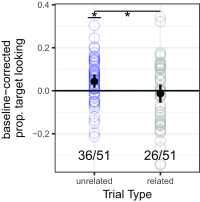Nature and origins of the lexicon in 6-mo-olds
- PMID: 29158399
- PMCID: PMC5724273
- DOI: 10.1073/pnas.1712966114
Nature and origins of the lexicon in 6-mo-olds
Abstract
Recent research reported the surprising finding that even 6-mo-olds understand common nouns [Bergelson E, Swingley D (2012) Proc Natl Acad Sci USA 109:3253-3258]. However, is their early lexicon structured and acquired like older learners? We test 6-mo-olds for a hallmark of the mature lexicon: cross-word relations. We also examine whether properties of the home environment that have been linked with lexical knowledge in older children are detectable in the initial stage of comprehension. We use a new dataset, which includes in-lab comprehension and home measures from the same infants. We find evidence for cross-word structure: On seeing two images of common nouns, infants looked significantly more at named target images when the competitor images were semantically unrelated (e.g., milk and foot) than when they were related (e.g., milk and juice), just as older learners do. We further find initial evidence for home-lab links: common noun "copresence" (i.e., whether words' referents were present and attended to in home recordings) correlated with in-lab comprehension. These findings suggest that, even in neophyte word learners, cross-word relations are formed early and the home learning environment measurably helps shape the lexicon from the outset.
Keywords: cognitive development; environmental effects; language acquisition; lexicon; word learning.
Conflict of interest statement
The authors declare no conflict of interest.
Figures




References
-
- Tincoff R, Jusczyk PW. Some beginnings of word comprehension in 6-month-olds. Psychol Sci. 1999;10:172–175.
-
- Tincoff R, Jusczyk PW. Six-month-olds comprehend words that refer to parts of the body. Infancy. 2012;17:432–444. - PubMed
Publication types
MeSH terms
Grants and funding
LinkOut - more resources
Full Text Sources
Other Literature Sources
Molecular Biology Databases
Miscellaneous

